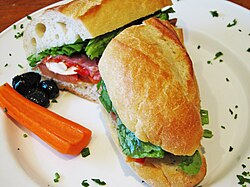Panini (sandwich)
 A panino imbottito | |
| Alternative names | Panino (Italian singular form), panino imbottito or panino ripieno (lit. 'stuffed panino') |
|---|---|
| Type | Sandwich |
| Place of origin | Italy |
| Serving temperature | Warm or room temperature |
| Main ingredients | Italian bread (not sliced bread), filling (meat, cheese, vegetables) |
A panini (/pəˈniːniː/; nowadays less commonly called panino, Italian: [pa'niːno])[1][2][3] is a sandwich made with Italian bread (such as ciabatta and michetta), usually served warm after grilling or toasting.
In many English-speaking countries, the name panini is given to a grilled sandwich made using various breads. The bread is cut horizontally and filled with deli ingredients, and often served warm after having been pressed by a warming grill.
Etymology
Panini is a word of Italian origin. In Italian, the noun panino (Italian: [pa'niːno]; pl.: panini) is a diminutive of pane (lit. 'bread') and refers to a bread roll. Panino imbottito (lit. 'stuffed panino') refers to a sandwich, but the word panino is also often used alone to indicate a sandwich in general. Similar to a panino is a tramezzino, a triangular or square sandwich made up of two slices of soft white bread with the crusts removed.[citation needed]
In English dominant countries, panini is widely used as the singular form, with the plural form panini or paninis, although some speakers use singular panino and plural panini as in Italian.[4][5][6][7]
History

Although the first US reference to panini dates to 1956, and a precursor appeared in a 16th-century Italian cookbook, the sandwiches became trendy in Milanese bars, called paninoteche, in the 1970s and 1980s. Trendy US restaurants began selling panini, with distinctive variations appearing in various cities.[8]
During the 1980s, the term paninaro arose in Italy to denote a member of a youth culture represented by patrons of sandwich bars, such as Milan's Al Panino, and Italy's first US-style fast food restaurants. Paninari were depicted as right-leaning, fashion-fixated individuals, delighting in showcasing early-1980s consumer goods as status symbols.[9][10][11]
See also
![]() Media related to Panini at Wikimedia Commons
Media related to Panini at Wikimedia Commons
References
- ^ "Definition of PANINI". www.merriam-webster.com. 2024-03-18. Retrieved 2024-04-09.
- ^ https://www.oxfordlearnersdictionaries.com/us/definition/english/panini
- ^ https://www.collinsdictionary.com/dictionary/english/panini
- ^ "panini". Oxford Dictionaries. Oxford University Press. Archived from the original on 14 July 2012. Retrieved 1 June 2016.
- ^ "Panini – Origin and Varieties". Taste and Flavours. 5 September 2012.
- ^ Denn, Rebekah (30 August 2005). "Ask The Critic: Panini vs. panino—a singular answer to a plural faux pas". Seattle Post-Intelligencer.
- ^ Butterfield, Jeremy (2016). Fowler's Concise Dictionary of Modern English Usage. Oxford University Press. p. 463. ISBN 978-0-19-966631-7. Retrieved 31 May 2016.
- ^ Zeldes, Leah A. (28 October 2009). "Eat this! Panini, Italy's answer to grilled cheese". Dining Chicago. Archived from the original on 31 October 2009. Retrieved 30 October 2009.
- ^ "paninari". Dizionario Italiano (in Italian). La Repubblica. Retrieved 27 April 2016.
- ^ "paninaro". Dizionario Italiano (in Italian). Corriere della Sera. Retrieved 27 April 2016.
- ^ "paninari". Vocabolario (in Italian). Treccani. Retrieved 27 April 2016.
Bibliography
- Katsigris, Costas; Thomas, Chris (2008). Design and Equipment for Restaurants and Foodservice: A Management View (third ed.). John Wiley & Sons, Inc. ISBN 978-0-470-44082-7.
- Strahs, Kathy (2013). The Ultimate Panini Press Cookbook: More than 200 Perfect-Every-Time Recipes for Making Panini – and Lots of Other Things – on Your Panini Press or Other Countertop Grill. Harvard Common Press. ISBN 978-1-55832-792-4.
- Tripodi, Anthony (2011). The Everything Panini Press Cookbook. Adams Media. ISBN 9781440527692.

